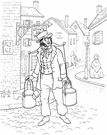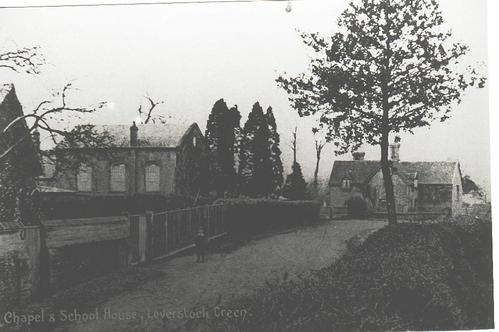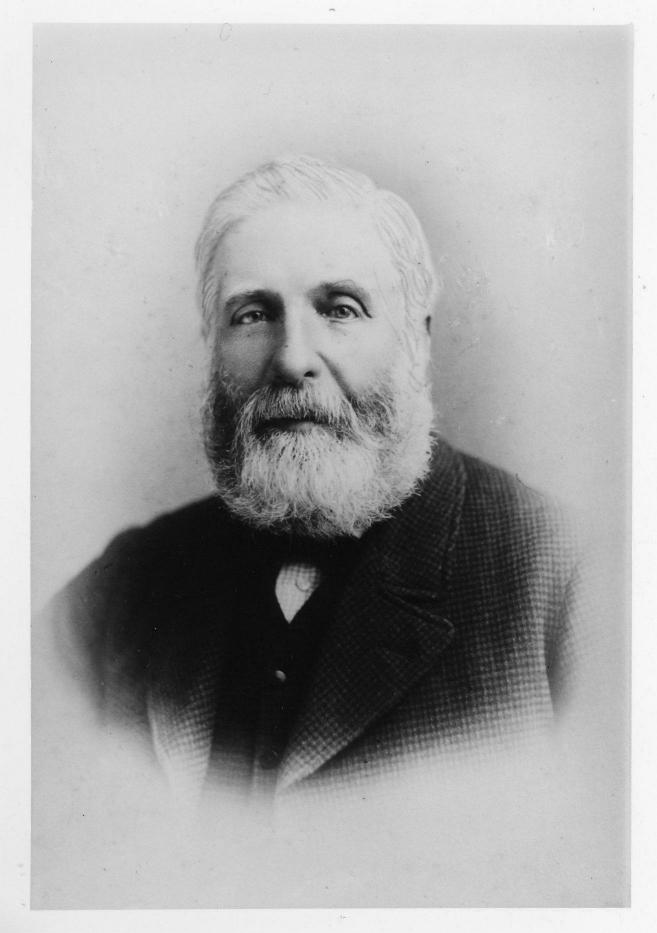1840 – According to the Tithe apportionment lists, the homestead at 988 ( Leverstock Green Farm) was occupied by a Joseph Smith, and the homestead at 982 (North End Farm ) was occupied by a William Smith, and was actually owned by Samuel Reynolds Solly rather than Charles Longman (The publisher). The actual mapping survey was undertaken in 1839, but I suspect the interviewing took place in 1840. The Tithe map also shows there to be two cottages built on the Green (now Church Cottages) at the time, given the number 236. The apportionment says: Land Owned by John Orchard and occupied by John Barnes & another 236 Cottage & Gardens.[HALS St. Michaels & Abbotts Langley Tithe Map & Apportionments]
29th September 1840 - At the Michaelmas Session of the Court at St. Albans, an order was given to "divert, turn or stop up part of a public highway or carriage road leading from Nash Mills to Leverstock Green and Bedmont". ( A further order was made concerning a footpath from Nash Mills to Hyde Farm, Bedmond.) It would seem likely that the road in question is either Chambersbury Lane or Bunkers Lane. Bearing in mind the way Chambersbury Lane digresses from its Medieval field boundary line as it nears Nash Mills, it would seem possible that this might be the case. If the plans are still held at St. Albans I may be able to verify this. The consent of the owners of the property concerned, Charles Stratham of Amersham, and his wife Sarah (from whom the right to the said property had come) had been sought and given. A certificate of completion would be given. [ S60 ] Sessions Roll CCXIX/ 213 - 228, & Sessions Book VI/ 364 - 367.
1840 -1850 - At some point during this decade the brickmakers cottages (known today as Kiln Cottages) off Woodlane End were built. I have arrived at these dates as the tithe map, which was surveyed in 1840, does not show cottages in "Shoulder of Mutton" field ( no. 1771 ), but instead lists it as Meadow land. Field no.1769 is, however, listed as "The Kiln Grounds", and several of the other fields in that immediate area, although either meadow or arable, have the word Kiln in their title. Assuming the tithe record to have been accurate, then we know the cottages were there before Dickens published Bleak House in 1852. (See entry for 1852.) As Dickens' description of the cottages shows them to be hovels, I think they must have been built immediately after the tithe survey, or else the tithe survey was not as accurate as we have previously supposed. [S72, S66 ]
Between 1840 & 1870 - By 1870 an additional cottage ( Church Cottages) was added to the two shown on the Tithe map. They are “now or late in the several occupations of Joseph Smith Junior Jeremiah Murble and John Dolt”. [S406]
1841 - The new Baptist chapel in the Bedmond Road was certified as a place of dissenting worship under the Toleration Acts of 1688-1852:
"The chapel in Leverstock Green was certified to the Archdeacon of St. Albans by the Rev. Thomas Hopley and Messers John George,R.Bruce,Thomas Orchard and John Orchard." [ S49 ]
This chapel was an offshoot of the Marlowes congregation, and was known to support a large Sunday School in successive years. [ S1 p.256, S421 ]
Interestingly although the Tithe apportionment for Abbots Langley ( in whose parish this was) was published in 1844, the Chapel didn't feature in it, nor was it shown on the Tithe map. The reason for this was that they survey was carried out in 1840. [ S97 ]
1841 – The census for 1841 showed John Kiff aged 75, to be living at what we now know as Dell cottage. In the early 20th century it was known as Kiff’s farm.
30th January 1841 – a new Chapel of Ease for Leverstock Green was reported in the County Press, page 3. [HALS online services catalogue of Newspapers & Magazine articles which can be downloaded after running a search under the HERTFORDSHIRE NAMES ON LINE. http://www.hertsdirect.org/libsleisure/heritage1/HALS/ (checked 8th June 2010] See later entry for 1846
17th June 1841 Margaret Stebbing of Leverstock Green married Thomas Turner, also of Leverstock Green at St. Mary’s church Hemel Hempstead. [HALS online services catalogue of Newspapers & Magazine articles which can be downloaded after running a search under the HERTFORDSHIRE NAMES ON LINE. http://www.hertsdirect.org/libsleisure/heritage1/HALS/ checked 25 June 2009 – document available to purchase online]
July 1842 - A labourer called William Bradbury, from Hemel Hempstead parish, was found guilty, at the Midsummer Session of the County Court,of breaking into the house of John Deacon ( a beerhouse keeper) of Leverstock Green. He was also found guilty of stealing a picture and frame from John Deacon, valued at 1/6d. For this crime William Bradbury was sentenced to transportation (presumably to Australia) for 10 years. [S59]
July 1842 - William Ivey, alias Ivory, and James Dell, both labourers from Hemel Hempstead parish, were brought to trial at the Midsummer sessions of the County Court, for stealing horses from Daniel Franks of Boxmoor, Charles Orchard of Woodwells Farm, and Mark Pattison of Wood Lane End Farm. Ivey and Dell were acquitted. [ S59 ]
James Dell, according to the Hemel Hempstead Tithe survey, lived in a cottage owned by Joseph Finch [no. 1487 on the Tithe map]; near the entrance to Tile Kiln Lane off Leverstock Green Road); however, according to the Abbots Langley tithe map, Dell lived in one of the cottages at North End Cottage - it was 4 cottages at this time. If there were really two James Dell's, then it was the Mr. Dell who lived in Hemel parish who was taken to court, however it seems likely to me that after his trial, Dell moved to the cottage in Bedmond Road, in time to be surveyed for a second time!, [ S102, S96 ]
1843 - The Tithe apportionments for Hemel Hempstead and St. Michael's were published. Click here to go to seperate web page concerning the survey.
16 February 1844 - John Field of Chambersbury died, aged 50. In the 1841 census he had been listed as a farmer. In his will he left his money, household goods, and newly built house in Sibley's Orchard, and a three acre meadow to his wife Zilpha Dover Field. All other copyholds were to be sold by auction. These were Bunkers, Newhouse, farms and lands called Chambers and Chambersbury some of which had been Freehold purchased from the Court of Chancery and lately owned by William Fellowes. The resulting monies were used as legacies for all his nephews and nieces. As John Dickinson owned Chambersbury and Bunkers Farm by 1850 when his daughter and son-in-law moved in it seems likely he purchased the properties following the death of John Field [S262, S366]
12th July 1845 – Sarah Luck of High Street Green married James Franklin of Leverstock Green at St. Mary’s Hemel Hempstead. [HALS online services catalogue of Newspapers & Magazine articles which can be downloaded after running a search under the HERTFORDSHIRE NAMES ON LINE.http://www.hertsdirect.org/libsleisure/heritage1/HALS/ 25 June 2009 – document available to purchase online]
1846 - The whole of Hertfordshire was transferred from the Diocese of Lincoln to the Diocese of Rochester, therefore when the new church of Holy Trinity was built, it came under the authority of the Bishop of Rochester. [ S88 ]
1846 - A meeting was held at Abbots Hill ( home of John Dickinson ) which decided that a new church should be built in Leverstock Green, as it then formed the junction of St. Mary's, Hemel; St. Michael's (St.Albans); and Abbots Langley, each being at least 2 miles distant. The minutes of the meeting began:
"In consequence of an opinion having prevailed generally among landowners, clergy and gentry residing in the neighbourhood of St. Albans, Abbots Langley and Hemel Hempstead, that the district in and about Leverstock Green was insufficiently provided with Church Accommodation...."
At the end of the meeting, the following proposal had been accepted:
After that a list of subscribers was appended, ranging from £2 to £1,500. The Earl of Verulam gave the land on which both the church and the Vicarage were to be built.
1846 Population thought to be at least 1000 [ S2 p.3]
1846 The National School for both boys and girls, was built in the village in Bedmond Road,.( opposite to where Holy Trinity Church was later built,.) The school was built solely at the expense of the Rev. Edward Oswell, the curate of Abbots Langley, and cost about £200. It had originally been proposed to adapt an old Methodist chapel for the purpose ,until Mr. Oswell came forward with his offer. He had apparently purchased a copyhold site on which to erect the school.( Copyhold was not quite the same as freehold, as copyhold rights could be terminated at the will of the Lord of the Manor. This form of tenure persisted into the 1920's, but was finally done away with by The Law of Property Act, 1925.) This copyhold was not conveyed to trustees as Mr. Oswell wished to be able to withdraw the building and make it available for other purposes in the event of new schools being erected at a later date. The school was united to the National Society, and the Society made a grant of £10 towards fitting it out with seats and benches; the building was used for Divine Service on Sundays before Holy Trinity was built. Education was not free, parents had to pay 2d a week for each child until 1876. Log books for the very early years of the school do not appear to exist. The first recorded log we have is for 1863, when the first government grant was received and it became compulsory to keep one.
[ S77; S75;S27; S36;S46 ]
1846 A Teacher's House was built in Bedmond Road, paid for by public subscription. The exact date it was built is uncertain, though possibly 1833. The return to the National Society's Church Schools Enquiry of 1846/7 records the existence of a teachers house. ( See earlier entry for 1833 ) The house itself is supposed to have been erected on Manor waste land, and in 1970 there was no known instrument of title. Still standing today it is known as "Old School House". [S77;S27;S36 p.107,S46] For a picture of the school in Victorian times click here.
5th June 1847 – Hertfordshire Mercury, page 3, reported on the “rescue of goods” concerning John Deayton at Leverstock Green HALS online services catalogue of Newspapers & Magazine articles which can be downloaded, (https://www.hertsdirect.org/ufs/ufsmain?formid=HALS_INDEXES checked 8th June 2010]
10 July 1847 - The designs were accepted for the new church, the architect was Raphael Brandon. A quote from the minutes of acceptance reads:
"The Mason will be expected to make his own arrangements as to the supply and cost of flints. He being allowed to use those already collected - about 250 loads - at the price of 4/6 per load."
Brandon also designed the old Rectory ( demolished 1985 ). [ S2 p.4; S31 p.183 ]
August 1847 - The contract was signed with a Mr. Lilley of Measham, to build the church in Leverstock Green. The cost was £1,591,10s 6d. The stone mason was a Mr. Elliot of Leicester. [S2 p.4 ]
19th June 1848 - According to documents in the possession of Tim Wood, owner of Handpost Lodge, a poster showed that the cottage then on the site of Handpost Lodge was auctioned on the above date in two lots. The cottage was given as being of brick and tile with Lot 1 in the occupation of Charles Barnes and Lot 2 in the occupation of George Little. The cottage appears to have been in two lots until the 1930's when the present Handpost Lodge was built. (See entry for 1938) [S326]
Monday 9th October 1848 - On this day at 10 o'clock an auction was held at Kettlewells : "Of the Valuable Live & Dead Stock, farm and barn implements etc.." As with the auctions earlier this year at Kettlewells this was to comply with death duties; in this instance the death of Thomas Holinshead, who had been buried at St. Michaels church on August 18th . The Livestock comprised: "10 superior working horses, 3 two-year-old colts, 3 yearling colts, 4 sucking colts, a pony quiet to ride and drive, 5 milch cows, 2 bulls, 6 yearling heifers, 6 weaning cow calves, 2 bull calves, a sow and 8 pigs, 7 in-pig sows, and 1 boar, 33 store pigs, and 190 sheep and lambs.". The deadstock included: " 3 narrow wheel wagons, 7 broad & narrow wheel carts, a jockey cart and a pony cart" and various items of farm machinery and hardware. Altogether the sale fetched £1002 14s. [S337, S343]
January 22nd 1849 - The housekeeper from Tile Kiln, home of Thomas Franklin the brickmaker, died aged 65. Mrs Ann Lowe had been housekeeper to Mr. Franklin for 41 years according to the inscription on her memorial in St. Mary's churchyard. [S263]
March 1849 - The Licence for the Red Lion was license renewed for 7 years till Michaelmas 1856 [HALS D/Els B55]
August 1849 -The Church of Holy Trinity was completed after a great many problems and delays. These delays were brought about for the most part by the committee changing its mind over details. The oak pulpit was donated by John Dickinson and cost £30, the font, also a gift from John Dickinson cost £10. The original High Altar in Oak cost £16. [ S2 p. 4]
30th October 1849 -Holy Trinity Church was dedicated by the Bishop of Rochester ( it was in his diocese.) The Rectory was built at the church end of Pancake Lane. It was later called Daneshurst. (It was demolished in 1985 ) [S2 - p4 ]
November 10th 1849 - The "Illustrated London News" reported:
CHURCH OF THE HOLY TRINITY, LEVERSTOCK GREEN, NEAR ST. ALBAN'S HERTS
The church was consecrated on the 30th October, by the Lord Bishop of Rochester. Its erection originated in the munificence of the Earl of Verulam, who presented the site, and a large sum towards the cost of the building. The edifice is constructed in a substantial manner, and consists of a well-designed chancel, with vestry on the north side; a nave, north and south aisles, and south porch. The bells are hung in a double bellcote, at the west end. The style of the architecture is of the early part of the fourteenth century. The body of the church affords accommodation for four hundred persons in open benches; but at least six hundred were present on the day of the consecration. After this impressive ceremony, the service of the day was performed by the Rev. Mr. Hutchinson: and an excellent sermon was delivered by the Hon. and Rev. Edward H. Grimston. The design of the church, which has given universal satisfaction, was prepared more than three years since by Messrs. Raphael and J.Arthur Brandon, and has been carried out by the elder after the lamented decease of his brother. Adjoining the church is the Rectory House, also built from the design, and under the superintendence of the same architect: it is a commodious and appropriate structure."
The report included a charming engraving of the New Church at Leverstock Green, though the artist got carried away including gravestones which would not at the time have been present. An original copy of the press report is hung in the vestry, and the author is fortunate enough to have been given another copy. [ Illustrated London News,10/11/1849 ] For a look at the presscutting from the Illustrated London News, click on the thumnail below. The engraving below is the original (hanging in the sacristy) upon which the one in the ILN was based.
1849 - 1850, Charles P. Incledon was installed as Vicar of Holy Trinity in 1849. [ S2 ]
Mid 19th Century - According to Jonathan Hunn the following holdings can be said to have been of the sizes given. [S167, p.153]
Hillend: 226.6 acres
Wards this incorporates part of Breakspears and Megdell: 287.7 acres
Westwick Corner: 277.6 acres
Westwick Hall: 325.3 acres
1850 - According to the History of Hemel Hempstead and the VCH, the Ecclesiastical parish of Leverstock Green was formed. However, the ecclesiastical survey carried out on March 30th 1851 showed it still to be a consolidated chapelry at the time of the census. [ S1 - p.248 ] [ VCH p.216 ][S323]
Kellys Directory for 1850 gives very scanty detail on Leverstock Green. There was no individual entry for the village, and no obvious entries in the Abbots Langley section where they were to be found in a subsequent copy of the directory. To add to the difficulties, certain pages in the directory had been left out when it had been bound together, and these included a section listing the Tile and Brickmakers, of whom I would have expected there to be at least two or three!! I can only conclude that the publishers of Kellys worked several months ahead of their dates, and if the village in question was not a parish then it was excluded. In the case of Leverstock Green , this was despite the fact that there was a thriving industrial community, albeit a small one. Another anomaly, was that although when listing areas of Hemel, such as Boxmoor, it excluded Leverstock Green or Bennetts End, it did include Buncefield, which it noted was 2 miles East of Hemel Hempstead.
Despite the drawbacks mentioned above, there were two or three individual
entries listed, and these were as follows:
John Dickinson, farmer, Leverstock Green
Thomas Franklin, brickmaker and farmer, Bennetts End
John George, farmer, Cox Pond
Charles Orchard, farmer, Wells Farm ( This should read Woodwells Farm, see entry for 1842 )
Thomas Orchard, Bottom House;
Although Bottom House doesn't appear on the 1877 O.S. map, it is shown on both the 1766 map by Dury &
Andrews, and on the 1822 map by Bryant. It was situated just the St. Michael's side of the parish boundary, just to the north of Westwick Halsss ( where Westwick Row and Green Lane halsss,) and approximately where the roundabout at the end of Breakspear Way is today. Possibly the small pond shown on the current O.S. Maps, was at one time the water supply for this farmstead. There was a Bottom House mentioned in other documents as being within the parish of St. Michaels, but outside the Borough of St. Albans, and therefore was likely somewhere in the Leverstock Green area. Thomas Orchard was also given as being a Minister in the Baptist chapel in Leverstock Green.) [ Kel.Dir. ]
1850 - The first burial took place in Holy Trinity's churchyard. Numbers 1 and 2 seem to be missing from the register of burials, so the first known burial took place on 25th February, and was of Zilpah Horwood, aged 32, who lived in Leverstock Green. The officiating Minister was R. Richardson, the incumbent of Holy Trinity. There were a total of 8 burials at Holy Trinity during that first year, 5 of them being over the age of 40, 2, between the ages of 25 and 40, and 1 infant, Frederick Wilson, aged just 4 months. These numbers were untypical of the numbers for following years. It must be remembered that not all deaths within Leverstock Green ended up as burials within the churchyard of Holy Trinity, many families preferring to bury their dead where they had buried their ancestors, or burying their families in graveyards belonging to the various descenting churches. Similarly, not all burials were necessarily of Leverstock Green inhabitants. [ S76 ]
1850’s - Mathew Leno of CoxPond (presumably Snr.) played cricket for both the Hemel Hempstead and Boxmoor Cricket Clubs. [Hertfordshire Mercury Newspapers – via e-mail dated 02/01/2005 ]











